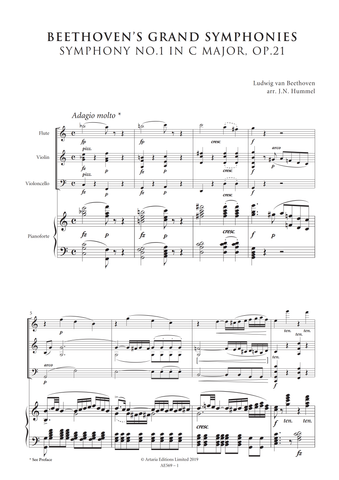Hummel, Johann Nepomuk: Oberons Zauberhorn, Op.116 Fantasie for Pianoforte & Orchestra (AE422) (*2009 Version) – sheet music
Previous Product Next Product
Description |
Hummel, Johann Nepomuk (1778-1837)
|
||||||||||||||||||
Audio sample |
|||||||||||||||||||
Details |
Hummel's autograph score, dated November 1829, styles the work L'Enchantement d'Oberon. Fantasie caracteristique but it is interesting to observe that neither the AMZ review nor the first edition, published in Vienna by Tobias Haslinger, in 1831 uses this title. Both refer to the work as either Oberons Horn [AMZ] or Oberons Zauberhorn [Haslinger], titles which more accurately reflect its relationship to the opera. Unlike Weber's earlier operas, which employ a number of unifying musical devices such as tonality and characterisation through orchestral colouring, Oberon, owing to the peculiarity of its structure, employs just one: the use of a horn call which opens the overture and appears as a motif at various points throughout the opera. It is this device, along with the use of the famous horn theme from the opera's finale, which provides the most obvious musical links between the two works although the horn motif itself is newly composed. Perhaps the most remarkable feature of Hummel's Oberon is how little material is taken directly from the opera. The only literal quotation indeed is the horn theme that forms the basis of the finales of both works. Even in terms of its recounting of the opera's dramatic action Hummel's Oberon differs considerably from its model. The Tempo di marcia, which is analogous to the march in the opera's Finale (No.23), precedes the storm scene (No.13) which in turn leads into a 'new' finale based around the horn theme (No.22). It is evident from this approach and Hummel's extensive use of newly-composed material that his primary concern was to achieve a satisfactory musical structure for his own composition rather than present a paraphrase of Weber's work. The newly-composed material is attractive, highly effective and characteristic of Hummel's mature style. Most impressive is Hummel's ability to achieve a sense of continuous musical action through the use of ingenious links between disparate thematic elements. Thus, the work unfolds as a long, continuous single movement but it contains five distinctive phases: Allegro energico (1), Larghetto (2), Tempo di marcia (3), Storm (4)Allegro con moto (5). The horn call opens the work and is used extensively within the orchestral accompaniment throughout the first phase of the work; it also serves as an introduction to the horn theme in the finale (and it is at this point that Hummel's decision to compose a new horn call rather than quote Weber's becomes self-evident since the new call is derived from the opening of the horn theme and thus serves to unify the work most effectively) and makes a final appearance in the last bars of the work. Allan Badley |
||||||||||||||||||
Score Preview (best viewed in full screen mode) |
|||||||||||||||||||











![Hummel, Johann Nepomuk: Le retour de Londres: Grand Rondeau brillant, Op.127 [Study Edition] (AE448/SE)](http://www.artaria.com/cdn/shop/products/AE448_SE_Score_A4_1stpage_cfa684e6-0f5d-4596-a96e-e061d759b968_large.jpg?v=1571438573)


